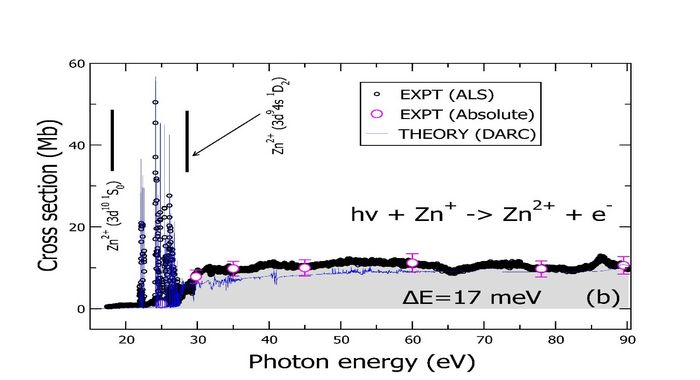ASTROPHYSICS
Petascale Computations for Atomic and Molecular Collisions: PAMOP and PAMOP2
Principal Investigator:
Alfred Müller
Affiliation:
Institut für Atom- und Molekülphysik, Universität Giessen (Germany)
Local Project ID:
PAMOP/PAMOP2
HPC Platform used:
Hazel Hen of HLRS
Date published:
Research efforts of an international group of scientists focus on the development of computational methods to obtain quantities that are required to understand and to model complex laboratory-based and astrophysical environments. Theory starts from the equations of motion that arise for atoms and molecules interacting with electrons or photons within a full quantum-mechanics description.
Access to leadership-class supercomputers available at the High Performance Computing Center Stuttgart (HLRS) allows us to benchmark the theoretical solutions obtained from these equations against measurable observables determined from dedicated collision experiments performed at leading large-scale experimental facilities in Europe and the USA. Furthermore, in the absence of experimental measurements, the highly effective and accurate method for obtaining theoretical results from this research provides atomic and molecular data for ongoing plasma modeling in research in laboratory and astrophysical plasma science [1,2]. This work could not even be attempted with access to leadership computational facilities like those at HLRS.
In order to achieve spectroscopic accuracy for direct comparisons with experiment, in particular for light or heavy systems [3 - 7] the computations include semi-relativistic or fully relativistic effects [8,9] and include an exponentially increasing number of target-coupled states. Computations of such complexity and magnitude could not be attempted without access to high performance computing resources at leadership computational facilities in Europe and the USA.
The scientists use a basis set method known as the R-matrix method [6], to solve the equations of motion to obtain the observables for the interaction of an electron or photon with atoms, molecules and their ions. The motivation for this work is multi-fold:
(a) Astrophysical applications
(b) Fusion and plasma modeling
(c) Fundamentally interesting
(d) Interpretation of experimental measurements at leading Light Source facilities
(e) Interpretation of Satellite observations.
(f) Provision of data for plasma diagnostics and modeling where no experimental data exist
For the heavy atomic systems we study, little atomic data exists and our current work provides insight into the collision and radiative processes necessary in fusion physics and provide urgently needed data for applications for plasma diagnostics and interpretation of gravity waves. Access to leadership computers available at HLRS allows us to refine and enhance our state-of-the-art codes. Examples of our work are illustrated below for both valence and inner-shell photoionization studies to illustrate the predictive nature of the methods employed and the insight gained from our work. Interpretation of experimental data is made possible using our calculations. We are able to trace the contributions from different initial states in the ion beam and determine the metastable fractions in the experiment. Our theoretical efforts continue to focus on the development of computational methods to solve the equations of motion for electron and photon interacting with atomic and molecular systems. With the trend towards exascale computing power, such as the new Summit the 200-petaflop IBM 922AC architecture at Oak Ridge National Laboratory our codes continue to evolve taking advantage of existing architectures at HLRS to develop, exploit and enhance our codes in preparation for these new machines.
Atomic Oxygen K-shell
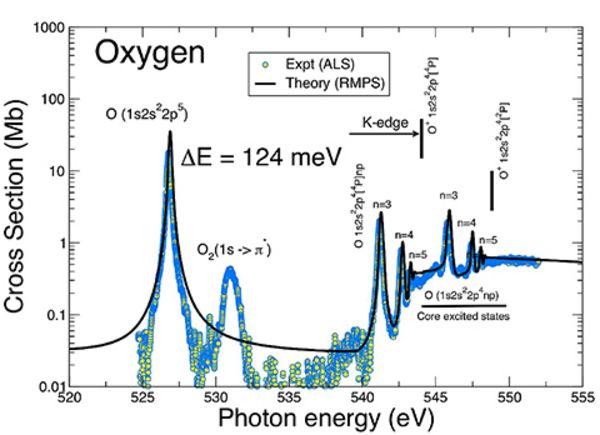
Fig 1: Atomic oxygen photo-absorption cross sections taken at 124 meV full-width-at-half-maximum (FWHM) at the Advanced Light Source (ALS) compared with theoretical estimates. The R-matrix calculations shown (solid black) are convoluted with a Gaussian profile of 124 meV FWHM [1]. © Queens University Belfast, CTAMOP
Atomic O5+ K-shell
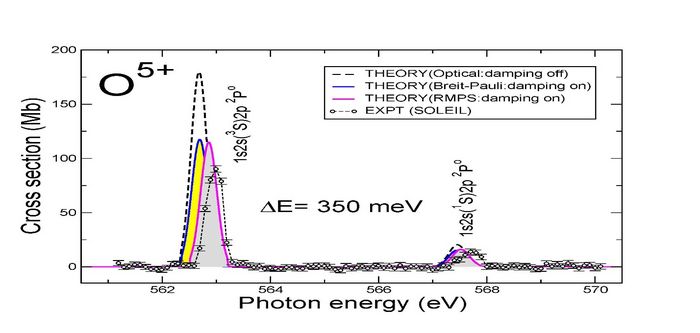
Fig 2: SOLEIL experimental K-shell photoionization cross-section of O5+ ions in the 561–570 eV photon energy range. Measurements were made with a 350 meV band pass. Solid points are experiment: The error bars give the statistical uncertainty. The different lines are the results of different theoretical approaches [22]. © Queens University Belfast, CTAMOP
Comparison of Satellite observations, and experimental studies
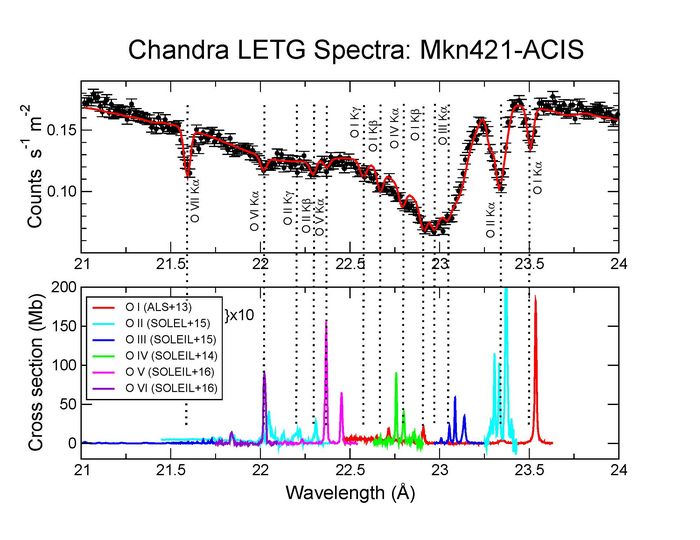
Fig 3: Top panel: Spectrum for the blazar Mrk 421 ACIS in the wavelength range of 21–24 Å composed from several different exposures with the Chandra satellite; Bottom panel: For the same wavelength range, measurements are illustrated from a combination of ground-based experimental spectra made at ALS and SOLEIL [22]. © Queens University Belfast, CTAMOP
Valence-shell Photoionization of W4+
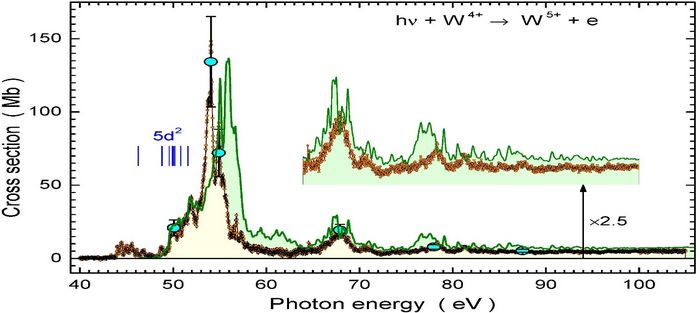
Fig. 4: Photoionization of W4+ ions: The statistically weighted sum of the results for all levels within the 4f145s25p65d2 configuration, i.e., the configuration-averaged cross section, obtained with a 730-level approximation was convoluted with a 200-meV FWHM Gaussian to simulate the experimental energy resolution of ALS measurements [21]. © Queens University Belfast, CTAMOP
Valence‐shell Photoionization of Ca+

Fig.6: Ca+ ions: Overview of the present experimental (panel (a)) and theoretical (panel (b)) results obtained for photoionization of Ca+ ions in the energy range 20–56 eV. The theoretical spectrum has been convoluted at 17meV FWHM for the comparison with the ALS measurements and an appropriate mixture of the ground and metastable states was used for the 594-level DARC calculations [24]. © Queens University Belfast, CTAMOP
References:
[1] B. M. McLaughlin, C. P. Balance, K. P. Bowen, D. J. Gardenghi, and W. C. Stolte, High-Precision K-shell Photoabsorption Cross Sections for Atomic Oxygen: Experiment and Theory, Astrophysical Journal, 771, L8 (2013)
[2] B. M. McLaughlin and C. P. Ballance, Photoionization, fluorescence and inner-shell processes, in McGraw-Hill Science and Technology Yearbook 2013, Edited by McGraw-Hill (New York and London) (2013), 281.
[3] Petascale computations for Large-scale Atomic and Molecular collisions, B. M. McLaughlin and C. P. Ballance, in Sustained Simulated Performance 2014, Chapter 15, Edited by, M. M. Resch, Y, Kovalenko, E. Focht, W. Bez and H. Kobaysahi, Springer (New York and Berlin) (2014)
[4] PAMOP: Petascale Atomic, Molecular and Optical Collision Calculations, B. M. McLaughlin, C. P. Ballance, M. S. Pindzola and A. Müller, in High Performance Computing in Science and Engineering 2015, Chapter 4, Edited by, W. E. Nagel, D. H. Kroener and M. M. Resch, Springer (New York and Berlin) (2015)
[5] PAMOP: Petascale Computations in Suport of Experiments, B. M. McLaughlin, C. P. Ballance, M. S. Pindzola S. Schippers, and A. Müller, in High Performance Computing in Science and Engineering 2015, Chapter 4, Edited by, W. E. Nagel, D. H. Kroener and M. M. Resch, Springer (New York and Berlin) (2016)
[6] PAMOP project: Computations in Suport of Experiments and Astrophysical Applications, B. M. McLaughlin, C. P. Ballance, M. S. Pindzola, P. C. Stancil, S. Schippers, and A. Müller, in High Performance Computing in Science and Engineering 2016, Chapter 4, Edited by, W. E. Nagel, D. H. Kroener and M. M. Resch, Springer (New York and Berlin) (2017)
[7] PAMOP: Large-scale Computations in Support of Experiments and Astrophysics Applications, B. M. McLaughlin, C. P. Ballance, M. S. Pindzola, P. C. Stancil, J. F. Babb, S. Schippers and A. Müller, in High Performance Computing in Science and Engineering 2017, Chapter 4, Edited by, W. E. Nagel, D. H. Kroener and M. M. Resch, Springer (New York and Berlin) (2018)
[8] I. P. Grant, Quantum Theory of Atoms and Molecules: Theory and Computation, Springer (New York, USA) 2007
[9] P. G. Burke, R-Matrix Theory of Atomic Collisions: Application to Atomic, Molecular and Optical Processes, Springer (New York, USA) (2011)
[10] B. M. McLaughlin and C. P. Ballance, Photoionization cross section calculations for the halogen-like ions Kr+ and Xe+, J. Phys. B: At. Mol. Opt. Phys. 45 095202 (2012)
[11] B. M. McLaughlin and C. P. Ballance, Photoionization cross section calculations for the tran-iron element Se+ from 18 to 31 eV, J. Phys. B: At. Mol. Opt. Phys. 45 085701 (2012)
[12] G. Hinojosa, A. M. Covington, G. Alna-Washi, M. Liu, R. A. Phaneuf, M. M. Sant'Anna, C. Cisneros, I. A'lvarez, A. Aguilar, A. L. D. Kilcoyne, A. S. Schlachter, C. P. Ballance and B. M. McLaughlin, Valence-shell photoionization of Kr+ ions: experiment and theory, Phys. Rev. A 86 063402 (2012)
[13] A. Müller, S. Schipper, D. Esteves-Macaluso, M. Habbi, A. Aguilar, A. L. D. Kilcoyne, R. A . Phaneuf, C. P. Ballance and B. M. McLaughlin, Valence-shell photoionization of Ag-like Xe7+ ions, J. Phys. B: At. Mol. Opt. Phys. 47 215202 (2014)
[14] E.T Kennedy et al, Photoionization of aluminumlike Si+ ion the region of the 2p threshold (94 – 137 eV) Phys Rev A 90 063409 (2014).
[15] M. Barthel, et al., Photoionization of 3s23p4 3P and the 3s23p4 1D, 1S states of sulfur: experiment and theory, Phys. Rev A 91 013406 (2015)
[16] B. M. McLaughlin, Photoionization of Cl+ from the 3s23p4 3P2,1,0 and the 3s23p4 1D2, 1S0 states in the energy range 19 – 28 eV, MNRAS 464, 1990 (2017)
[17] D. Macaluso, et al., Absolute single-photoionization cross sections of Se2+: experiment and theory, Phys. Rev. A 92 063424 (2015)
[18] A. Müller, et al., Single-photon single ionization of W+ ions: experiment and theory, J. Phys. B: At. Mol. Opt. Phys. 48 2352033 (2015)
[19] B. M. McLaughlin, et al., Photoionization of tungsten ions: experiment and theory for W2+ and W3+, J. Phys. B: At. Mol. Opt. Phys. 49 065201 (2016)
[20] J.-M. Bizau, et al., K-shell photoionization of O+ and O2+ ions: experiment and theory, Phys. Rev. A 92 023401 (2015)
[21] A. Müller, et al., Photoionization of tungsten ions: experiment and theory for W4+, J. Phys. B: At. Mol. Opt. Phys. 50 085007 (2017)
[22] B. M. McLaughlin, et al., K-shell photoionization of O4+ and O5+ ions: experiment and theory, MNRAS 465, 4690 (2017)
[23] B. M. McLaughlin, et al., Single photoionization of the Zn II ion in the photon energy range 17.5 – 90 eV: experiment and theory, MNRAS, 470, 4048 (2017).
[24] A. Müller, et al., Photoionization of Ca+ ions in the valence energy region 20 – 56 eV: experiment and theory, J. Phys. B: At. Mol. Opt. Phys. 50 205001 (2017)
Scientific Contacts:
Brendan M McLaughlin and Connor P Balance
Centre for Theoretical Atomic, Molecular and Optical Physics (CTAMOP)
School of Mathematics and Physics
Queens University Belfast
The Old Physics Building
Belfast BT7 1NN/UK
b.mclaughlin [@] qub.ac.uk or c.ballance [@] qub.ac.uk
Mitch S Pindzola
Department of Physics
206 Allison Laboratory
Auburn University,
Auburn, AL 36849/USA
Phillip C Stancil
Department of Physics and Astronomy
Center for Simulation Physics
University of Georgia
Athens, GA 030602-2451/USA
James F Babb
Institute for Theoretical Atomic, Molecular and Optical Physics (ITAMP)
60 Garden Street, MS-14
Harvard Smithsonian Center for Astrophysics
Cambridge, MA 02138/USA
Stefan Schippers and Alfred Müller (PI)
Institut für Atom- und Molekülphysik,
Justus-Liebig-Universität
Leihgesterner Weg 217, D-35392 Giessen/Germany
HLRS Project ID: PAMOP/PAMOP2
May 2018
